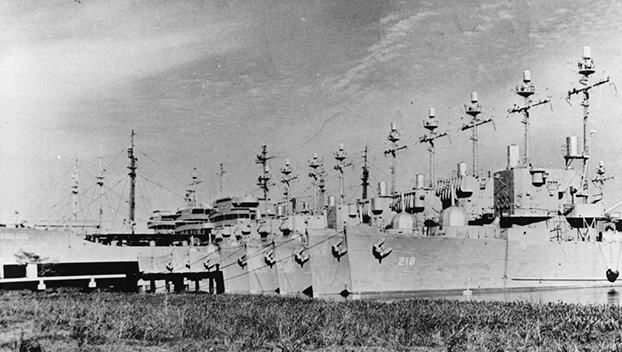HISTORY IN SPOTLIGHT — Orange had one of the Navy’s largest bases
Published 12:18 am Wednesday, August 9, 2023

- The Reserve fleet is seen in Orange. The base was part of the Texas Group, Atlantic Fleet with a one-time purpose to deactivate and provide maintenance for ships transferred to the reserve fleet. (Heritage House Museum)
|
Getting your Trinity Audio player ready...
|
In Orange from the late 1940s to the mid-1970s was a large fleet of U.S. Navy ships. It was unofficially called a “Mothball Fleet.” Most of us did not realize it at the time but it was the largest fleet of inactive ships in the world.
Orange had a Navy presence since 1940 when Congressman Martin Dies, an Orange native, lobbied Congress to grant a contract for U.S. Steel to build destroyers for the U.S. Navy. Among the first things built by the Navy was a housing project to provide for the naval personnel who would be arriving in Orange.
During the WWII years destroyers, destroyer escorts, auxiliary vessels of several types and wooden minesweepers were built for the U.S. Navy and the Royal Navy by the three shipyards in Orange.
Trending
READ MORE — Historic Naval Barracks finding new mission in Orange.
After the war ended, in August 1945, the Navy announced it would build a $2 million base for the storage of inactive Navy ships.
Construction would soon start on the first of 12 piers on the Sabine River and bids were sought for the construction of the base.
The first buildings built were the administration building and barracks for the naval personnel to be assigned to the new base.
Orange had been selected because of the naval presence already there, and the fresh water of the Sabine River would be less corrosive to the ships than a saltwater site.
The base would be part of the Texas Group, Atlantic Fleet. The purpose of the base would be to deactivate and provide maintenance for ships transferred to the reserve fleet.
Trending
Captain W. E. Guitar, USN, was named commander of the Texas Group. Captain T. R. Cowie, USN, was named as the first commander of the Orange base.
On Nov. 5, 1945, the USS Matagorda, AVP 22, a seaplane tender, was the first vessel to arrive.
In 1946 land along the river including part of the Riverside housing addition was cleared for the berthing area and the remainder of the 12 piers.
The administration building, barracks and warehouses would eventually cover 166 acres of land.
At completion there would be 150 ships initially berthed at the base. The aim was to be “A berthing station where ships were maintained in a standby state of readiness.” Of the eight such bases, the Orange base would be the largest of the U.S. Navy and the largest in the world.
In 1951 the base became headquarters for the 16th United States Fleet, Inactive. The value of the ships was estimated to be $400,000,000.
Commander Ben T. Brown, USN, was assigned as base commander in 1965. A year later he was asked about the economic impact of the base to the City of Orange.
Brown replied the payments for local labor, coupled with civilian and Naval contracts had totaled $2.5 million dollars and the payrolls for civilian and naval personnel had totaled $291,468. He further stated the Navy had poured an average of $3 million into Orange economy annually.
Naval personnel worked alongside civilians when needs had arisen. An example was during the flood of 1953 when forces were needed to sandbag the levee around Orange to contain the rise of the river.
The fire department at the base had a mutual aid agreement signed with the Orange Fire Department if and when the need arose.
The base had been renamed the Naval Inactive Ship Maintenance Facility of Texas. Its new mission was to inspect and either restore, dehumidify and maintain the ships or to “scrap” or sell them to some allied country.
During the Korean War years, 1950 to 1954, 43 ships were reactivated for use by the U.S. Navy.
In 1967 the largest ship berthed in Orange was the USS Spokane, CL-120, a light cruiser, 6,000 tons, 541 feet long, and 75,000 horsepower. There were 44 destroyers, 40 destroyer escorts, 25 minesweepers, and various barges and drydocks. There were also 44 APDs.
APDs were unique ships. They were destroyers converted into transports capable of carrying 200 troops. They were used for small unit amphibious attack forces, like Marine raiders. The ships were high-speed transports capable of giving fire support to the landing forces.
There were a total of 189 vessels berthed in Orange with another 39 vessels under Cmdr. Brown’s command in the marine reserve in Beaumont. Also under his command were seven tankers, 13 tugs, five transports in Beaumont with another 14 vessels at Mobile, Alabama. These were auxiliary vessels that required a different maintenance than the ships at Orange.
At this time Cmdr. Brown had 12 officers, 23 enlisted personnel and 188 civilian employees under his command.
In 1974 things would change in Orange. It was announced the base would close.
That year the U.S. Navy sent notice to the City of Orange stating as of June 30, 1976, the inactive ship maintenance base would be closed. The notice also stated the ships would be removed by the end of 1976.
This document signaled the end of a 34-year relationship between the U.S. Navy and the City of Orange. It also meant personal relationships between naval personnel and citizens of Orange would be ending. The lines of grey naval vessels along Destroyer Street behind the heavy chain link fence would soon be disappearing. There would be a void in Orange, for some a sense of personal loss.
The Navy adopted a policy in 1974 that ships would be deactivated in their home ports. The base at Orange was too remote. There were no vessels home ported anywhere near Orange. The base would no longer be needed, it would become surplus property.
The base had been slowly downsizing. Over several years naval personnel had been reduced and about 100 civilian jobs had been eliminated.
In 1974 Commander John H. Vosseller had been assigned base commander. Under his command were only 24 naval personnel and 68 civilian employees.
Closing the base would reduce the navy’s annual expenditure by $631,000. The loss would hurt Orange. Businesses that for three decades had been supplying supplies to the base and personal goods to the base personnel, naval and civilian, would lose an important source of revenue.
For nearly two years plans had been moving forward to close the base. It soon became evident all of the ships could not be moved out by the end of 1976. It would take five years until the last ship was moved from Orange.
The Navy could not sell its ships as “scrap” in the sense that the ships could be sent to breakers and cut down into scrap metal. “Scrapped ships” could be sold to allied navies once they were decommissioned and struck from Navy records.
In the 1970s U.S. Navy uniforms became scarce around Orange. The uniformed sailors now being seen in Orange were from countries like Mexico, Korea, Nationalist China and South American countries, notably Peru and Ecuador.
The destroyers, destroyer escorts and minesweepers were the first to be sold off with the auxiliary ships, drydocks, and floating shops being sold off in time.
The vacant base began to be sold in parcels. U.S. Steel acquired some acreage for its American Bridge facility. The Orange County Navigation and Port District bought buildings and land along the river where the piers were located. A small portion of land was deeded to Lamar University.
The Navy kept 18 ½ acres for use as the U.S. Navy and Marine Corps Reserve Training Center. Eventually the Navy closed the Reserve Center and sold that property.
Today, very little of the old base is still used as it was at the time of its demise.
The old power plant building was stripped of all its equipment. The vacated building was then used by the Southeast Texas Vietnam Veterans Association. Due to storm damage the building was torn down.
Thousands of people attend events held on the river today. Few realize the street from Simmons Drive to the boat ramp and the parking area crosses the site of Riverside, once the largest housing project built in the United States.
When they reach the river and turn right toward the boat ramp, they are on the site of what was once the largest naval base of its type in the world.
— Written by Mike Louviere, who can be reached at mike.louviere@gmail.com.





